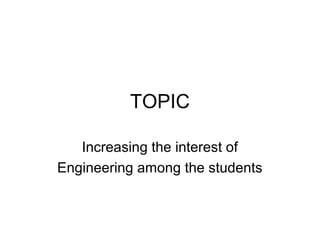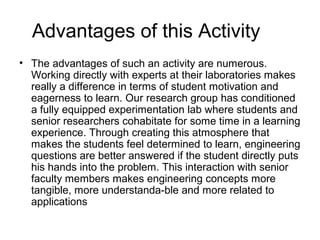How to increase the interest of Engineering among students
- 1. TOPIC Increasing the interest of Engineering among the students
- 2. INTRODUCTION ? Project based activities are a good way to expose secondary school students to more science andmath at earlier grades. Children are naturally curious about the world around them. Science is the perfect vehicle to answer many of their questions when they try to solve a problem. Unfortunately,as children grow older, they may perceive engineering as a difficult and unknown subject,. For this reason , We suggest our university an activity , with the aim of increasing the interest of students for technology and promote engineering skills, capabilities and values.
- 3. Advantages of this Activity ? The advantages of such an activity are numerous. Working directly with experts at their laboratories makes really a difference in terms of student motivation and eagerness to learn. Our research group has conditioned a fully equipped experimentation lab where students and senior researchers cohabitate for some time in a learning experience. Through creating this atmosphere that makes the students feel determined to learn, engineering questions are better answered if the student directly puts his hands into the problem. This interaction with senior faculty members makes engineering concepts more tangible, more understanda-ble and more related to applications
- 4. ? The activity presented in this paper, inspired on the ideas of MIT SeaPearch, has been designed for students from 19- to 22-year-old, and its aim is to increase the demand for engineering degrees. The report presented here shows the first results of a workshop to build a remotelyoperated underwater robot. The robot is fully built by a team of 8-10 students during a 2?-day workshop, which ends with the students showing their ability to teleoperate it and to execute underwater challenging operations that are realistic approaches to real missions developed by the real Remotely Operated Underwater Robots (ROVs). These operations consist in collecting metallic parts from the bottom of the pool and placing them into a cargo (cleaning operations), launching and releasing objects using different techniques (as if they were scientific instrumentation moored on the seabed to collect data), etc . Some of these missions can only be accomplished
- 5. ? Figure 1. facility at Swan swimming pool. This facility we have near our University where we ? can test those robots The maximum number of participants is 50 students, which would build 5 underwater robot prototypes.by following collaborative strategies using more than one vehicle .The robot prototype is built using low-cost materials, with a total cost not exceeding 5000 rupees . Another important purpose of this activity is to introduce the students into the correct and safe utilization of standard tools.
- 6. II. DEVELOPMENT OF THE ACTIVITY The workshop is supervised by three faculty members. It would takes place in the swimming pool under the water Facility and a laboratory provided in university with all the necessary equipments to supply such an activity , So this activity could held at Iqra National university because they have these facilities and for testing the robot we have Swan Swimming pool next to the University. (see Figures 1)
- 7. A. Welcome presentations 3 The workshop starts with three short presentations . In the first one, the professors welcome the students and introduce themselves. Some instructions are given and the group starts familiarizing with the environment and the tools. In most cases, this will be the first contact of students with the senior faculty members and, therefore, kindness and closeness are a must to minimize their fears while keeping the appropriate levels of respect. Professors try to encourage motivation and provide positive feedback to the students to create a positive atmosphere, which always helps when starting to work with an unknown group of pupils. As stated in , every learning process concerns with an emotional domain where the pupils play a fundamental role.
- 8. ? A multimedia presentation is given next, accompanied with individual documentation of the whole activity. Safety advices about tools and their correct utilization receive a special attention during all the presentation. The students are going to start a serious project, and for that purpose they need real, professional tools. It is important to remark that the safety elements (protective goggles, gloves, aprons, etc.)
- 9. B. First Day of the Workshop The first task of the students is to build the teleoperation unit illustrated in . Theconsole is made out of wood. Students must assemble the spare parts using wood glue and nails.It requires about 1 hour to cut the spare wood parts, make the needed holes on it and assemble the whole console. While the pupils wait for the glue to dry, they can start constructing the vehicle's. The structure is made of PVC pipes of different lengths linked together by means of T¡¯s, 90? and 45? elbows. Students measure and cut all the pipes using the appropriate tools. The chassis, once finished, is used as a starting point to explain and understand the dynamics and force-torque vectors acting on an underwater vehicle. The chassis construction takes around 1 hour
- 10. B. First Day of the Workshop The first task of the students is to build the teleoperation unit illustrated in . Theconsole is made out of wood. Students must assemble the spare parts using wood glue and nails.It requires about 1 hour to cut the spare wood parts, make the needed holes on it and assemble the whole console. While the pupils wait for the glue to dry, they can start constructing the vehicle's. The structure is made of PVC pipes of different lengths linked together by means of T¡¯s, 90? and 45? elbows. Students measure and cut all the pipes using the appropriate tools. The chassis, once finished, is used as a starting point to explain and understand the dynamics and force-torque vectors acting on an underwater vehicle. The chassis construction takes around 1 hour










